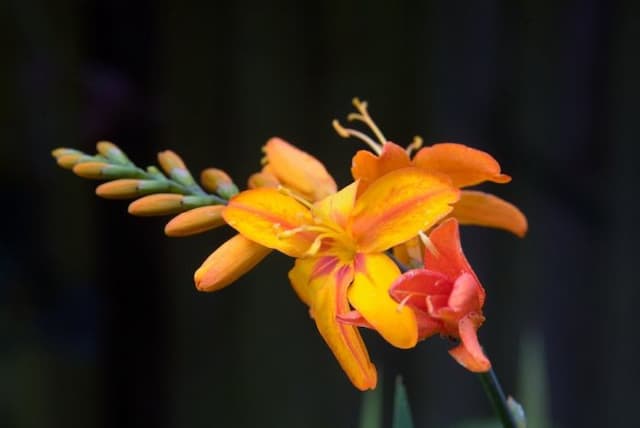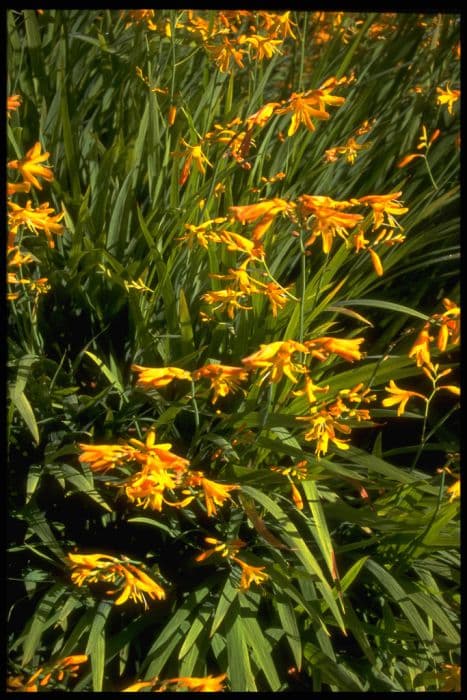Tall Bearded Iris Iris 'Norfolk Belle' (TB)
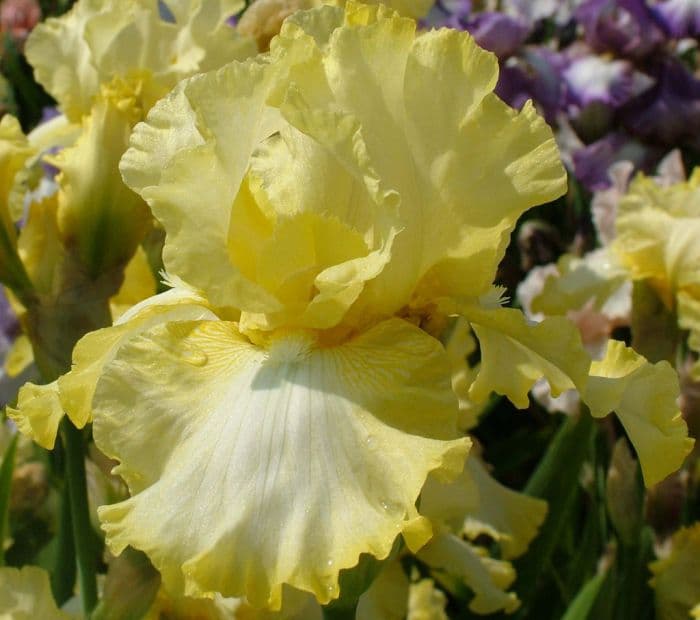
ABOUT
The Iris 'Norfolk Belle' is a bearded iris that displays a captivating appearance, comprising a range of colors which makes it a striking addition to any garden. The flowers showcase ruffled petals that are colored in gentle shades of pastel pink and peach, which can give the impression of a soft sunrise. The petals have a velvety texture and are adorned with the characteristic "beard" that is a fuzzy strip in a contrasting hue, often a vibrant orange or yellow, running down the center of the lower petals, known as falls. The foliage of the Iris 'Norfolk Belle' is equally elegant, with long, slender leaves that emanate from the base of the plant in a fan-like formation. These leaves are a rich green color that contrasts nicely with the delicacy of the blooms. The combination of these exquisite flowers and the lush foliage contributes to a display that brings both color and architectural interest to gardens during their blooming season. Overall, this variety of the bearded iris is celebrated for its soft, romantic colors and classic floral beauty.
About this plant
 Names
NamesFamily
Iridaceae
Synonyms
Norfolk Belle Tall Bearded Iris, Norfolk Belle Iris
Common names
Iris 'Norfolk Belle' (TB)
 Toxicity
ToxicityTo humans
The Tall Bearded Iris, which includes the 'Norfolk Belle' variety, is considered to have a low level of toxicity to humans. However, all parts of the plant, especially the rhizomes (the underground stems), can cause mild stomach upset if ingested. Symptoms of ingesting Iris parts can include nausea, vomiting, abdominal pain, and diarrhea. The severity of symptoms depends on the amount consumed. Handling the plant can also cause skin irritation in some individuals due to the presence of irritant substances known as irisin, iridin, or irisine.
To pets
The Tall Bearded Iris, which includes the 'Norfolk Belle' variety, is also toxic to pets, such as dogs and cats. The rhizomes contain the highest concentration of toxic compounds and can cause digestive upset if ingested, leading to symptoms such as salivation, vomiting, diarrhea, lethargy, and abdominal pain. While ingestion of small quantities may only result in mild gastrointestinal upset, consumption of larger amounts could lead to more severe symptoms and warrant a visit to the veterinarian.
 Characteristics
CharacteristicsLife cycle
Perennials
Foliage type
Deciduous
Color of leaves
Green
Flower color
Mixed
Height
3 feet [0.91 meters]
Spread
2 feet [0.61 meters]
Plant type
Bulb
Hardiness zones
3
Native area
Temperate Northern Hemisphere
Benefits
 General Benefits
General Benefits- Ornamental Appeal: Iris 'Norfolk Belle' enhances gardens with its striking flowers and elegant foliage.
- Drought Tolerance: Once established, this tall bearded iris is relatively tolerant of drought, making it a good option for water-conservative gardens.
- Low Maintenance: Requiring minimal care other than occasional division, Iris 'Norfolk Belle' is ideal for gardeners seeking low-maintenance plants.
- Cold Hardy: It is capable of withstanding colder climates, making it suitable for a variety of temperate gardens.
- Attracts Pollinators: The blooms of Iris 'Norfolk Belle' attract bees, butterflies, and other beneficial pollinators, supporting local ecosystems.
- Seasonal Interest: With its spring blooming season, this tall bearded iris provides a burst of color after winter, helping to mark the change of seasons.
- Versatile Landscaping: It can be used in a range of garden designs, from borders to focal points, or even mass planting for a dramatic effect.
- Adaptable: Iris 'Norfolk Belle' can grow in a variety of soil types, although it prefers well-drained soils.
 Medical Properties
Medical PropertiesThis plant is not used for medical purposes.
 Air-purifying Qualities
Air-purifying QualitiesThis plant is not specifically known for air purifying qualities.
 Other Uses
Other Uses- Iris 'Norfolk Belle' can be used for natural dyeing, providing a range of colors from its petals for fabrics and yarns.
- The sturdy leaves of the iris can be woven into small baskets or decorative mats, showcasing traditional crafting techniques.
- Pressed iris flowers are often used in scrapbooking or as embellishments in greeting cards for their intricate shape and vibrant colors.
- Dried iris petals can serve as a component in potpourri mixes, offering a subtle fragrance and splash of color to a room.
- This iris variety can be incorporated into floral waters or infusions for a scented rinse or bath additive, excluding any direct therapeutic claims.
- As a subject in photography, Iris 'Norfolk Belle' offers an ethereal beauty that can be harnessed in art prints and posters.
- The tall and elegant structure of the iris can be used as a natural support for smaller, delicate plants in a mixed planting scheme.
- Iris seeds can be used in educational settings to teach children about plant biology and the life cycle of flowering plants.
- The striking appearance of the iris can inspire designs and patterns in textiles, such as on fabrics for clothing or home decor.
- When planted in mass, Iris 'Norfolk Belle' can act as a soil stabilizer on slopes or banks, to help prevent erosion and runoff.
Interesting Facts
 Feng Shui
Feng ShuiThe Iris is not used in Feng Shui practice.
 Zodiac Sign Compitability
Zodiac Sign CompitabilityThe Iris is not used in astrology practice.
 Plant Symbolism
Plant Symbolism- Hope - The Iris often symbolizes hope, conveying a sense of anticipation and belief in a positive future.
- Wisdom - In some cultures, Irises are said to represent wisdom, reflecting a deep knowledge or enlightenment.
- Courage - The flower is also associated with courage, embodying the spirit of bravery and the ability to face challenges.
- Faith - Often connected with faith, the Iris can represent a strong conviction and trust in personal beliefs or spiritual systems.
- Purity - The Iris is sometimes viewed as a symbol of purity, likely due to the striking and pristine appearance of its flowers.
- Royalty - Due to the regal appearance of its blooms, the Iris can symbolize royalty and an air of majesty or nobility.
 Water
WaterFor the Tall Bearded Iris, it's essential to provide consistent moisture during the growing season, especially during dry spells. Water this iris deeply once a week, supplying about an inch of water, which is approximately 0.6 gallons per square yard. Avoid overhead watering to prevent issues with rot, and instead, use a soaker hose or drip irrigation system to deliver water directly to the soil.
 Light
LightThe Tall Bearded Iris thrives in full sun conditions. It prefers at least six hours of direct sunlight daily. An ideal spot would be in a flower bed that receives unfiltered morning sunlight and partial shade in the hottest part of the afternoon.
 Temperature
TemperatureThe Tall Bearded Iris is hardy and can tolerate a range of temperatures, from as low as 14 degrees Fahrenheit during dormancy to as high as 90 degrees Fahrenheit during the growing season. The ideal growing temperature for this iris is between 55 and 75 degrees Fahrenheit, which encourages vigorous growth and optimal blooming.
 Pruning
PruningPruning the Tall Bearded Iris involves cutting back the flower stalks to the base after blooming to encourage healthy growth and prevent seed development. Remove any damaged or diseased leaves at this time. In late summer or early fall, trim foliage to a height of about 4 to 6 inches to prepare for winter and promote air circulation.
 Cleaning
CleaningAs needed
 Soil
SoilThe Tall Bearded Iris 'Norfolk Belle' requires well-draining soil with a slightly acidic to neutral pH between 6.5 and 7.0. A good soil mix for this iris can be made by combining 2 parts loam, 1 part sand, and 1 part compost to provide ample nutrients and improve drainage.
 Repotting
RepottingTall Bearded Irises like 'Norfolk Belle' typically do not require frequent repotting and should be divided every 3 to 5 years to maintain vigor and flower production.
 Humidity & Misting
Humidity & MistingTall Bearded Iris 'Norfolk Belle' is tolerant of a wide range of humidity levels and does not require specific humidity conditions, making them adaptable to most climates.
 Suitable locations
Suitable locationsIndoor
Place in bright, indirect light and ensure good air circulation.
Outdoor
Ensure full sun, well-drained soil, and avoid waterlogged areas.
Hardiness zone
3-9 USDA
 Life cycle
Life cycleThe Iris 'Norfolk Belle' (Tall Bearded Iris) begins its life as a rhizome, which is a type of underground stem capable of producing the roots and shoots necessary for growth. Upon breaking dormancy in early spring, new shoots emerge from the rhizome, leading to the development of long, sword-shaped leaves and a flowering stalk. The plant blooms in late spring to early summer, displaying its distinctive flowers that attract pollinators for sexual reproduction. After flowering, seed pods may form, although many gardeners remove these to encourage more vigorous plant growth. Throughout the summer, the foliage continues to photosynthesize, providing energy for the rhizome to store. As autumn approaches, the foliage begins to die back, and the plant enters a period of dormancy during the winter months, conserving energy within the rhizome for the next growing cycle.
 Propogation
PropogationPropogation time
Late Summer to Early Fall
Propogation: The most popular method for propagating the Iris 'Norfolk Belle', also known as the Tall Bearded Iris, is through division. This is best done in late summer, after the blooming period when the rhizomes have new growth. To propagate through division, dig up the iris clump carefully to avoid damage to the rhizomes. Clean the soil off the rhizomes and inspect them for signs of disease or damage; discard any that are not healthy. Using a sharp knife, cut the rhizomes apart, ensuring that each division has at least one healthy fan of leaves and a portion of the root system. Shorten the leaves to about one third of their original length, which is approximately 4 to 6 inches (10 to 15 centimeters), to reduce water loss while the newly planted division establishes. Replant the divisions at least 12 to 24 inches apart (30 to 60 centimeters), placing the rhizome just at or slightly below the surface of the soil, and water well to settle the soil around them.
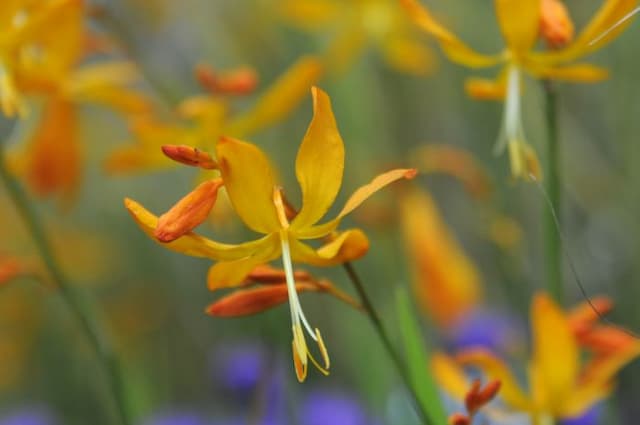
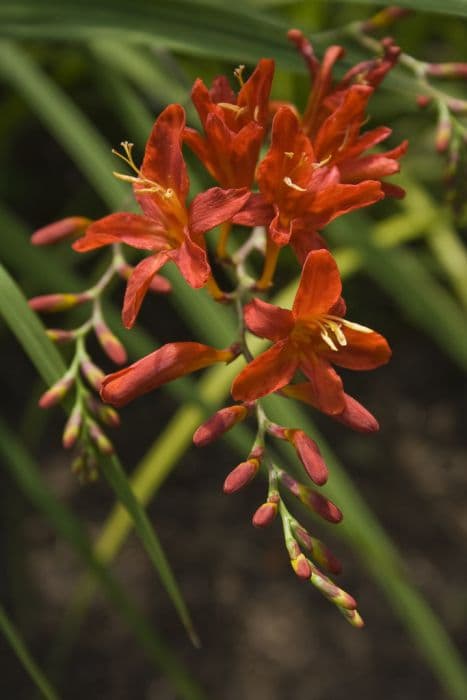
![Montbretia [Bright Eyes]](/_next/image?url=https%3A%2F%2Fplants-admin.emdemapps.com%2Fimages%2Fplants%2F%2Fimages%2F604b5f4a483b6.png&w=640&q=75)
